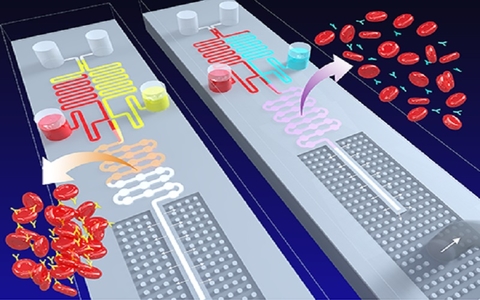Since day one, the tech industry has been trying to shrink every electronic component and device to near microscopic size to make them more mobile, impressive to look at, and viable for use in harsh and difficult environments. Obviously, the medical industry is not immune to this quest for shrinkage.
In light of that, it should not be bowel-shaking news that somewhere, at any given time, scientists are trying to squeeze a medical lab onto an integrated circuit the size of half a postage stamp, a.k.a., the ever popular ‘lab on a chip” scenario. Should this also be a quest dear to you, let not your heart be troubled. A multidisciplinary research team at the University at Buffalo claims to have fabricated such a chip, or very close to one.
Imagine a handheld device that lets a doctor draw blood from a patient (or other victim) and in a few seconds the device analyzes the blood sample an provides a comprehensive medical profile of the subject and his or her condition(s). If you view not having such a device as problem, again, let not your heart (or digestive system) be troubled. A study, appearing in a recent edition of the journal Lab on a Chip, indicates scientists are getting significantly closer to solving the aforementioned problem. Checkout the abstract for some details.
The study describes how at the University at Buffalo research team fabricated a chip that employs two types of force to manipulate how fluids travel in micro- and nano-sized channels. The two diverse types of force employed are capillary- and vacuum-driven force.
This approach, say the researchers,solves an elusive problem. They claim, because in such devices, when blood is mixed with a reagent to produce a biological and/or chemical reaction, the pressure difference between the two fluids often causes them to flow backward instead of into the desired channel. Kwang W. Oh, PhD, UB associate professor of electrical engineering and biomedical engineering, and the study’s lead author explains, “It’s kind of like plumbing; we’re moving fluids around and dealing with different pressures and flows. Only we’re doing it on a microchip, as opposed to a house. The chip could become the basis for faster, more efficient and reliable lab on a chip devices. It puts us closer to using such devices where medical labs are lacking, such as the developing world, battlefields and even our homes.”

Via their experiments, the team demonstrated how its chip was able to accurately decipher the eight blood types based upon the time it takes for different blood types to flow through the chip. For example, when mixed with a certain antibody, Type A blood will thicken and flow slower.
Oh says the device could be used for other biological and chemical assays. What’s more, the new chip requires no sensors or external sources of power. That’s key for medical device manufacturers, which are searching for ways to inexpensively produce disposable lab-on-a-chip products.
For more information, and to ease your beating heart (or digestive distress), more information is available.